Podiatry board - guidelines for endorsement for scheduled medicines
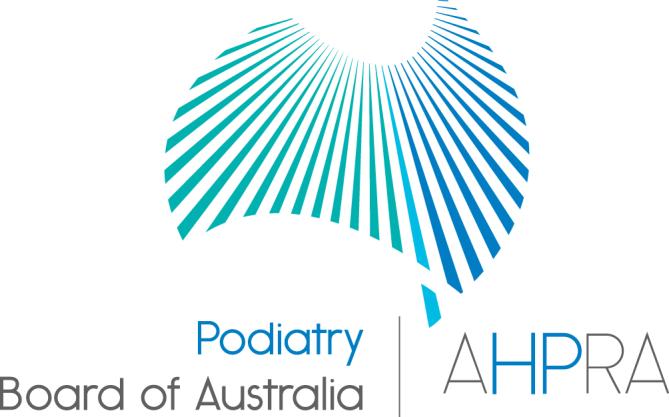
Guidelines for Endorsement for
Scheduled Medicines
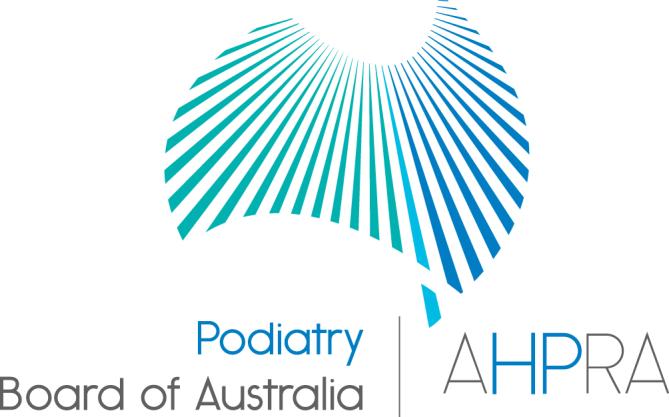
Guidelines for Endorsement for Scheduled Medicines
The Podiatry Board of Australia (the Board) has developed these Guidelines for Endorsement for Scheduled Medicines (Guidelines) under section 39 of the Health Practitioner Regulation National Law Act (the National Law) as in force in each State and Territory.
The purpose of these Guidelines is to assist podiatrists applying for the first time or renewing an endorsement for scheduled medicines.
These guidelines supplement the requirements set out in the Board's Endorsement for Scheduled Medicines Registration Standard.
There are provisions in relevant State and Territory drugs and poisons legislation for podiatrists with general registration to use specified restricted medicines (for example, local anaesthetics) in podiatry practice. Podiatrists with the knowledge and skills to use these specified medicines are able to continue to access these restricted medicines without an endorsement for scheduled medicines.
The Board has determined that a podiatrist with an endorsement for scheduled medicines has the necessary knowledge and skills to prescribe and supply the particular scheduled medicines specified in Appendix B to these Guidelines. These Guidelines provide information on the following topics:
Scheduled medicines authorisation
Requirements for endorsement for scheduled medicines Pathways to endorsement for scheduled medicines
Application for endorsement for scheduled medicines Other relevant Registration Standards
Audit Endorsement for Scheduled Medicines: Clinical Practice Guidelines (Clinical Practice Guidelines)
Definitions Flow Chart 1 – Pathways to endorsement for scheduled medicines
The following documents are included in the Appendix to the Guidelines:
Appendix A – Clinical Practice Guidelines
Appendix B – List of Scheduled Medicines Approved by the Podiatry Board of Australia (the
National Podiatry Scheduled Medicines List).
Appendix C – relevant sections of the National Law
Podiatry Board of Australia Australian Health Practitioner Regulation Agency
www.podiatryboard.gov.au 15 March 2011
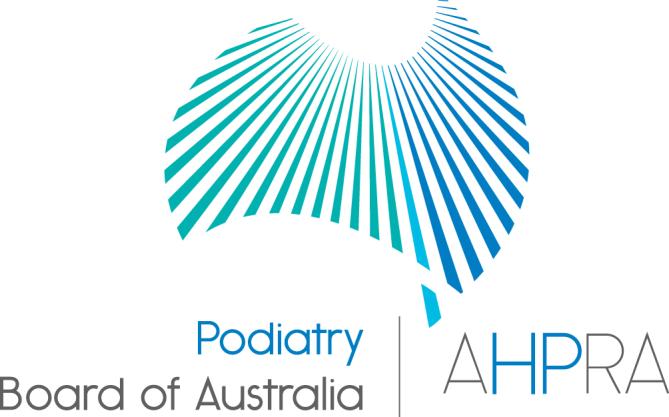
Note: A podiatrist who holds a scheduled medicine endorsement is able to prescribe or supply
scheduled medicines only to the extent of the authority conferred under the drugs and poisons
legislation in the jurisdiction in which they practice.
Scheduled medicines authorisation
Which scheduled medicines can be prescribed or supplied?
In each State and Territory, the scheduled medicines that can be prescribed, supplied or used by a podiatrist or podiatric surgeon are clearly listed in the relevant drugs and poisons legislation. The list of scheduled medicines may vary from one jurisdiction to the next. The podiatrist must be familiar with and comply with the requirements of the legislation relating to scheduled medicines in each jurisdiction in which they practise podiatry. Health departments in each State and Territory have information relating to the drugs and poisons legislation.
In some States and Territories, an endorsement for scheduled medicines is required for a podiatrist with general registration to be able to prescribe or supply scheduled medicines. The scheduled medicines relate to a list of Schedule 2, 3, 4 or 8 medicines specified in Appendix B to these guidelines. These guidelines provide guidance to application for and renewal of the endorsement for scheduled medicines.
To assist podiatrists, the Board has provided an Overview which includes the following information:
The current relevant drugs and poisons legislation for each State and Territory The contact information for State and Territory Health Departments
The scheduled medicines authorisations in Drugs and Poisons regulations for:
o Podiatrists with general registration o Podiatric surgeons o Podiatrists who are authorised to use an extended range of restricted drugs, under State
and/or Territory legislation
o Podiatrists with an endorsement for scheduled medicines.
This Overview is an appendix to the Information Package found at the Board's website
Requirements for endorsement for scheduled medicines
The Board's role is to ensure that podiatrists with an endorsement for scheduled medicines are
appropriately qualified to prescribe or supply Schedule 2, 3, 4 or 8 medicines to patients for the treatment
of podiatric conditions, from the List of Scheduled Medicines Approved by the Podiatry Board of
Australia (the National Podiatry Scheduled Medicines List) at Appendix B.
The Board has developed an ‘Information Package for Endorsement for Scheduled Medicines'
(referred to as the Information Package in these Guidelines). An applicant seeking an endorsement for
scheduled medicines needs to be familiar with the Information Package and is responsible for ensuring the
Information Package is known to those health practitioners who are asked to write references, offer clinical
Podiatry Board of Australia Australian Health Practitioner Regulation Agency
www.podiatryboard.gov.au 15 March 2011
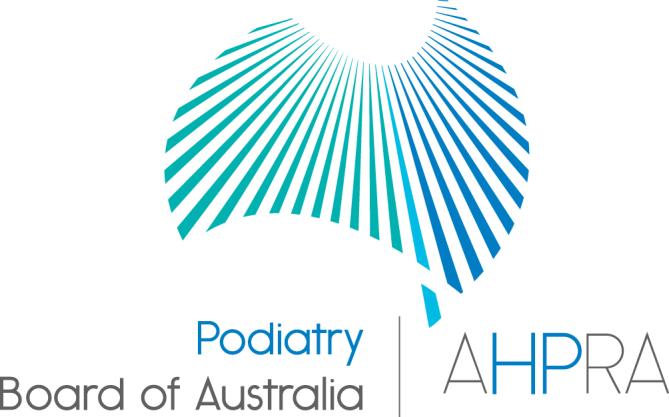
experience and who undertake the role of the Supervisor. The Information Package is found at the Codes and Guidelines section of the Board's website.
Pathways to Endorsement for Scheduled Medicines
The requirements for endorsement are set out in the Board's Endorsement for Scheduled Medicines Registration Standard. An applicant for a scheduled medicine endorsement must follow one of two pathways before an application can be made to the Board. See Flow Chart 1 on page 9 of this document.
Approved Program of Study in Podiatric Therapeutics
For the purpose of the Board's Endorsement for Scheduled Medicines Registration Standard the Board will accept the following as an approved program of study in podiatric therapeutics:
A program of study in podiatric therapeutics that has been accredited for this purpose by the
Australia and New Zealand Podiatry Accreditation Council [ANZPAC] and approved by the Board
A program of study that transitioned on the commencement day of the National Law as an
‘approved program of study in podiatric therapeutics' (section 283 of the National Law)
A program of study in podiatric therapeutics that, in the Board's opinion, is substantial y
equivalent to, or based on similar competencies to, an approved program of study (section 94 (1) (a) (ii) of the National Law).
A list of the approved programs of study is located on the Board's website and in the Information Package.
Pathway 1
The applicant must have:
1. Successfully completed an approved program of study in podiatric therapeutics or a program of
study determined by the Board to be substantially equivalent to an approved program of study and
2. Clinical experience of seven years, post-qualification as a podiatrist, in an appropriate setting
where active prescribing is occurring and
3. Two confirmatory references of the applicant's exposure to and participation with podiatric
patient care involving restricted medicines.
For the purpose of these Guidelines the Board has defined the following:
Clinical experience of seven years is defined as the equivalent to working seven years full time
i.e. working 38 hours/week, 48 weeks/year, for seven years.
Active prescribing refers to a clinical setting where the podiatrist is being involved in clinical
decision making and participating in determining pharmacological management of patients with podiatric conditions.
Two confirmatory references. A reference is required from each of two clinicians confirming the
podiatrist has completed seven years of clinical experience and has had adequate experience in observing and participating in the administration and prescription of a variety of classes of
Podiatry Board of Australia Australian Health Practitioner Regulation Agency
www.podiatryboard.gov.au 15 March 2011
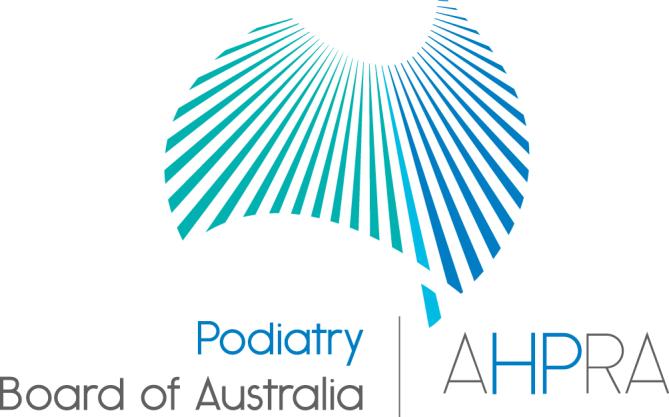
restricted medicines for various foot related conditions. The two clinicians providing the reference must be medical practitioners or podiatrists with endorsement for scheduled medicines. Details of information required in the references for the Board to assess the application for endorsement are provided in the Information Package.
Pathway 2
The applicant must have successfully completed:
1. An approved program of study in podiatric therapeutics or a program of study determined by the
Board to be substantially equivalent to an approved program of study; and
2. Web-based case studies approved by the Board (20 hours); and
3. 40 sessions of supervised practice (supervision by an endorsed prescriber approved by the Board)
in an appropriate setting and where active prescribing is occurring, within a 12-month period.
For the purpose of these Guidelines the Board has defined the following:
Web-based case studies approved by the Board. The Board has determined that 20 hours of
Board approved web-based case studies equate to 15 Board approved web-based case studies. Providers of web-based case studies are found in the Appendix to the Information Package. Evidence of the successful completion of the web-based case studies is required with the application for endorsement.
40 sessions of supervised practice. The Board has determined that the evidence to demonstrate
40 sessions of supervised practice, as required in the Endorsement for Scheduled Medicines Registration Standard, will include:
o A Supervisor Agreement as detailed in the Information Package, and
o 40 Log Sheets written by the applicant as detailed in the Information Package, and
o Certificate(s) of Completion of Supervised Practice as detailed in the Information Package.
These documents must be included with the application for endorsement.
Endorsed prescriber. An endorsed prescriber approved by the Board to supervise the applicant's
clinical experience will be a registered medical practitioner or a podiatrist endorsed for scheduled medicines.
Further detailed information regarding the pathways is provided in the Information Package.
Therapeutics Update Course (Pathway 1 and Pathway 2)
Before deciding to endorse a podiatrist's registration for scheduled medicines the Board must be satisfied that the podiatrist is competent to practise podiatry in accordance with an endorsement for scheduled medicines. Under the National Law, the Board may endorse a podiatrist's registration for scheduled medicines, and impose any conditions that it considers necessary or desirable in the circumstances. If the Board does not consider that the podiatrist has adequate recent experience in relation to administering, using or prescribing the medications on the National Podiatry Scheduled Medicines List the
Podiatry Board of Australia Australian Health Practitioner Regulation Agency
www.podiatryboard.gov.au 15 March 2011
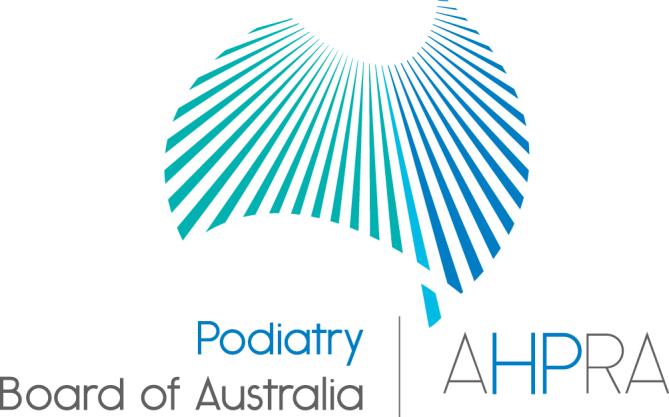
Board may endorse the podiatrist's registration for scheduled medicines and impose a condition that a
therapeutics update course approved by the Board be successfully completed before commencing
activities under their endorsement for the first time.
The Board recommends that podiatrists complete a therapeutics update course before submitting their
application for endorsement.
The aim, specific objectives and details of approved therapeutics update courses and the education
providers are included in the Appendix to the Information Package.
Applications for endorsement for scheduled medicines
The Information Package will assist the registrant with the application for endorsement for scheduled medicines. The documentation in the package must be used by the podiatrist when submitting the application.
Who can apply for endorsement?
Podiatrists with general registration who have successfully met the requirements of either Pathway 1 or
Pathway 2.
An applicant after successfully completing an entry-level program of study may seek an endorsement for
scheduled medicines immediately after the successful application for general registration. An applicant will
require evidence of successful completion of:
An approved program of study in podiatric therapeutics; and
Board approved web-based case studies [20 hours]; and
40 sessions of supervised practice as described in this Guideline and as detailed in the
Information Package.
Podiatric surgeons who are seeking endorsement for scheduled medicines need to successfully meet the
requirements of either Pathway 1 or Pathway 2.
Overseas qualified podiatrists who are seeking endorsement for scheduled medicines need to
demonstrate equivalency of standards in education and/or training or have completed a course of study
approved by the Board. These podiatrists will be expected to have completed education and training
procedures equivalent to current Australian standards.
Applications may be lodged with AHPRA when the applicant has completed the requirements of either Pathway 1 or Pathway 2. An application form for Endorsement of Registration for Scheduled Medicines for Podiatrists is available on the Board's website in the ‘Forms' section.
Other registration standards
Applicants for endorsement for scheduled medicines must also satisfy all other relevant Registration Standards of the Board and particularly:
Podiatry Recency of Practice Registration Standard
Podiatry Continuing Professional Development Registration Standard
Podiatry Board of Australia Australian Health Practitioner Regulation Agency
www.podiatryboard.gov.au 15 March 2011
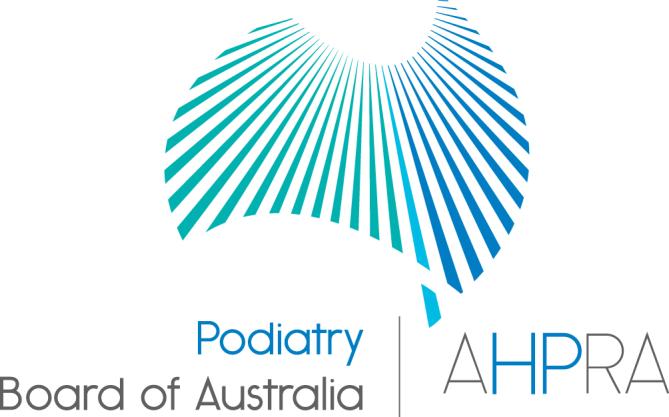
Podiatry Professional Indemnity Insurance Registration Standard
Podiatrists with an endorsement for scheduled medicines must continue to meet other Registration
Standards, including: continuing professional development (CPD) requirements for endorsement for
scheduled medicines and professional indemnity insurance (PII) for their practice.
Annual renewal of an endorsement for scheduled medicines is required and occurs at the same time as renewal of general registration. Rules relating to fees and late applications will apply. See the Fees section on the Board's website for additional information.
The Board will randomly audit podiatrists with endorsement for scheduled medicines annually.
Endorsement for Scheduled Medicines: Clinical Practice Guidelines (Clinical Practice Guidelines)
The Board's Endorsement for Scheduled Medicines Clinical Practice Guidelines is at Appendix A and addresses aspects of practice for podiatrists with scheduled medicines endorsement, including:
1. Communication with other members of the patient's treating team 2. The scheduled medicines that a podiatrist endorsed for scheduled medicines is qualified to
administer, obtain, possess, prescribe, sell, supply or use (see the National Podiatry
Scheduled Medicines List at Appendix B).
The Board endorses the registration of a podiatrist for scheduled medicines under section 94 of the National Law. Endorsed podiatrists must comply with the Clinical Practice Guidelines of Scheduled Medicines developed and approved from time to time by the Board in accordance with section 39 of the National Law and published on the Board's website at:
Note: A podiatrist who holds a scheduled medicine endorsement is able to prescribe or supply
scheduled medicines only to the extent of the authority conferred under the drugs and poisons
legislation in the jurisdiction in which they practice.
Definitions
For the purpose of these Guidelines:
Scheduled medicines: Section 5 of the National Law defines to scheduled medicines as meaning ‘a
substance included in a Schedule to the current Poisons Standard within the meaning of the Therapeutic
Goods Act 1989 of the Commonwealth'. The expression ‘scheduled' refers to any drug, poison or
substance listed in the Commonwealth Standard for the Uniform Scheduling of Medicines and Poisons
(SUSMP or commonly called the Poisons Standard). The SUSMP allocates categories that form Schedules
to the SUSMP:
Schedule 2 (S2) ‘Pharmacy Medicine' Schedule 3 (S3) ‘Pharmacist Only Medicine'
Podiatry Board of Australia Australian Health Practitioner Regulation Agency
www.podiatryboard.gov.au 15 March 2011

Schedule 4 (S4) ‘Prescription Only Medicine'
Schedule 5 (S5) ‘Caution' Schedule 6 (S6) ‘Poison'
Schedule 7 (S7) ‘Dangerous Poison' Schedule 8 (S8) ‘Control ed Drug'
Schedule 9 (S9) ‘Prohibited Substance'
Information Package for Endorsement for Scheduled Medicines. The Information Package is the
Board's information and document package, updated from time to time as required, and provides guidance
to registrants who apply for endorsement for scheduled medicines.
Podiatry Board of Australia Australian Health Practitioner Regulation Agency
www.podiatryboard.gov.au 15 March 2011
Flow Chart 1 * For explanatory details, you must see the
Guidelines for Endorsement for Scheduled Medicines and the Information Package
Pathways to Endorsement for Scheduled Medicines
An applicant for endorsement must follow either Pathway 1 or Pathway 2 as illustrated below
Pathway 1
Pathway 2
*Approved Program of
*Approved Program of
Study in Podiatric
Study in Podiatric
Therapeutics
Therapeutics
*Seven years' Experience
in an Active Prescribing
*Completion of Approved
Web-based Case Studies
*Supervised practice:
*Two References Confirming
Clinical Experience with the
40 Log Sheets, each 'signed-
National Podiatry Scheduled
off' by the supervisor
Application Sent to AHPRA
Application Assessed by the Board
*Meet all Registration Requirements
Podiatry Board of Australia Australian Health Practitioner Regulation Agency
www.podiatryboard.gov.au 15 March 2011
Appendix A
Endorsement for scheduled medicines: Clinical Practice Guidelines
Clinical guidelines and protocols for podiatrists with endorsement for scheduled medicines
These Clinical Practice Guidelines address the following clinical aspects of scheduled medicines endorsement for podiatrists:
1. Communication with other members of the patient's treating team
2. The scheduled medicines that the podiatrist with endorsement for scheduled medicines is
qualified to prescribe or supply - see Appendix B for the List of Scheduled Medicines
Approved by the Podiatry Board of Australia (the National Podiatry Scheduled
Medicines List).
1. Communication with other members of the patient's treating team
A number of health practitioners are often involved in providing care to patients. This may be referred to as shared care. Within a shared care arrangement it is recognised that patient care is provided by two or more practitioners, each practising within his or her sphere of expertise. Shared care aims to co-ordinate patient care to provide high-quality, integrated care that is readily accessible and convenient to the patient and cost-effective for all parties involved. Communication and clear demarcation of roles and responsibilities are essential for effective shared care.
1.1 Ethical and legal obligations associated with shared patient care
Podiatrists participating in shared care must be competent to collect data according to set protocols and must ensure they have the equipment, expertise and skills required to perform their role safely and effectively. An appropriate level of professional indemnity insurance is required. Podiatrists must act in the best interest of the patient at all times. The needs and requirements of the patient must determine the decision of where and/or when to refer the patient. The patient should be informed of alternative management, providers and facilities. In a shared care arrangement, the practitioner who actually writes and signs the prescription carries the accountability for prescribing the medications.
1.2 Informed financial consent
Patients must be informed that the medications prescribed by podiatrists with endorsement for scheduled medicines are not eligible for the Pharmaceutical Benefits Scheme (PBS) rebate and therefore may cost more to the patient than if prescribed by a medical practitioner.
1.3 Communication in shared patient care
Communication is the lynchpin of effective shared care. Open discussion, communication and documentation are paramount. Participating practitioners and their patients must understand clearly which practitioner is responsible for providing each of the various aspects of care.
To avoid repetition and confusion, each treating practitioner must have a clear understanding of:
Podiatry Board of Australia Australian Health Practitioner Regulation Agency
www.podiatryboard.gov.au 15 March 2011
The diagnoses, treatment(s) and ongoing recommendations to the patient of the other
treating practitioners
The information to forward to others involved in the patient's care Timeframes in which this information should be forwarded
The preferred format for this information
Who is responsible for ongoing patient care and the follow-up of patients who miss
scheduled appointments
The roles and responsibilities of each person participating in the shared care.
The use of standardised protocols and forms are recommended to clarify responsibilities and facilitate the transfer of information and communication between practitioners involved in shared care. Such systems may involve standardised forms used by all parties participating in the shared care arrangement, or may be a less regimented arrangement which places emphasis on contemporary communicated documentation. As a minimum requirement, practitioners sharing patient care should have a clear understanding of which tests should be completed during review appointments.
Ongoing discussion between the podiatrist with endorsement for scheduled medicines and the involved medical practitioner should review these protocols and make any changes necessary over time to ensure optimal patient care. All practitioners involved in shared care of patients should receive a copy of the results of any review appointments the patient attends.
1.4 Required communications
Formal consultation and communication with others in the patient's treating team aims to achieve safe and effective care.
Due to the potential for systemic effect and/or the requirement for a definitive diagnosis or more extensive treatment, the Board requires podiatrists with endorsement for scheduled medicines to establish processes for clear communication and consultation with a medical practitioner for certain drug classes in Schedule 4, for example in the management of gout and mycosis where ongoing health monitoring is required. The podiatrist with endorsement for scheduled medicines is required to prescribe in accordance with these Clinical Practice Guidelines.
1.5 Patient involvement in shared care
In a shared care arrangement, patients must be clearly informed of who maintains responsibility for their primary care and when they are required to attend reviews with each practitioner. Patients must be provided the opportunity to choose whether or not they wish their care to be shared between the general practitioner and their podiatrist. Similarly, the patient reserves the right to seek a second opinion if they so choose. Written information for patients regarding shared care may prove a useful adjunct to verbal discussions with their podiatrist who has the endorsement for scheduled medicines.
Podiatry Board of Australia Australian Health Practitioner Regulation Agency
www.podiatryboard.gov.au 15 March 2011
2. The National Podiatry Scheduled Medicines List
The National Podiatry Scheduled Medicines List (at Appendix B) is the scheduled medicines that have
been approved by the Podiatry Board of Australia, for podiatrists with an endorsement for scheduled
medicines to administer, obtain, possess, prescribe, sell, supply or use for the treatment of podiatric
conditions.
Appropriate current references and resources should be available to podiatrists with scheduled medicines endorsement. Such references include but are not limited to:
Australian Medicines Handbook (AMH) available on CD RO
Therapeutic Guidelines: essential titles for podiatry: Antibiotic, Analgesic, Dermatology,
Endocrinology, Toxicology and Dental.
MIMS Annual together with bi-monthly addenda or MIMS CD or E-Mims
The Merck Manual of Diagnosis and Therapy, Merck Sharp & Dohme
General Practice by J. Murtagh Recent textbook on Clinical Pharmacology e.g.
A textbook of pharmacology, Bryant B, et al (2005) Medical Pharmacology at a Glance, Neal MJ (2009)
Australian Prescriber and Adverse Drug Bulletin Australian Medical Journal
The National Podiatry Scheduled Medicines List specifies the Schedule 2, 3, 4 and 8 drugs that an
endorsed podiatrist is qualified to prescribe or supply. Certain drugs (or routes of administration) will be
restricted to those podiatrists with endorsement for scheduled medicines who have a demonstrated clinical
need, such as podiatric surgeons. The National Podiatry Scheduled Medicines list details these
restrictions in the column headed Endorsement.
Currently, as podiatrists do not have direct access to the required range of diagnostic services, certain agents require specific communication pathways with the patient's general practitioner (see sections 2.1 Antimycotic agents; 2.2 Antibacterial agents; and 2.3 Anti-inflammatory agents in these Clinical Practice Guidelines).
In relation to the National Podiatry Scheduled Medicines List:
A Podiatrist is defined as a registered podiatrist with an endorsement for scheduled medicines. A Podiatric Surgeon is defined as a podiatrist registered as a podiatric surgeon under the National
Podiatrists must be familiar with and comply with the requirements of State and Territory drugs and
poisons legislation, as relevant to their practice of podiatry in a jurisdiction – refer to the Board
document titled "Endorsement for Scheduled Medicines – Overview".
Podiatry Board of Australia Australian Health Practitioner Regulation Agency
www.podiatryboard.gov.au 15 March 2011
2.1 Antimycotic agents
At initiation of oral therapy by a podiatrist with endorsement for scheduled medicines, a medical practitioner
must be informed and requested to assist in monitoring the systemic status of the patient, in line with the
principles of shared care.
2.2 Antibacterial agents
A medical practitioner must be notified if there is no improvement in clinical signs of infection after one
course of antibacterial therapy (current Therapeutic Guidelines: Antibiotics indicate this to be seven (7) to
ten (10) days), irrespective of which member of the shared care practitioners commenced the therapy. The
treatment plan (including consideration of further investigations or treatments) needs to be communicated
with and agreed jointly by the patient's shared care practitioners. Further, if an infection worsens during the
course of treatment, the choice and dose of agent must be reviewed with referral for further investigation if
indicated.
2.3 Anti-inflammatory agents
No course of treatment initiated by a podiatrist with endorsement for scheduled medicines shall exceed seven (7) days without direct involvement of a medical practitioner.
In the case of initial diagnosis and treatment for gout, a medical practitioner must be notified. The medical
practitioner should be requested to undertake further confirmatory diagnostics (unless already arranged by
the podiatrist) and to undertake the long-term management of the condition.
Podiatry Board of Australia Australian Health Practitioner Regulation Agency
www.podiatryboard.gov.au 15 March 2011
Appendix B
The National Podiatry Scheduled Medicines List
Antimycotic agents
Schedule 2
Topical preparations containing 0.25% or less of amorolfine.
Cream 1% and Lotion 1%
Dermal preparations 2%
Dermal preparations
Dermal preparations
Schedule 3
For topical use containing more than 0.25% of amorolfine
Schedule 4
In conjunction with shared care arrangement.
Mitosis Inhibitors
In conjunction with shared care arrangement.
Podiatry Board of Australia Australian Health Practitioner Regulation Agency
www.podiatryboard.gov.au 15 March 2011
Antibacterials
Schedule 4
Prolonged treatment (>10 days) should only be considered with additional medical advice
Prolonged treatment (>10 days) should only be considered with additional medical advice
In association with a hospital
admission (including a registered day surgery facility).
Prolonged treatment (>10 days) should only be considered with additional medical advice
Prolonged treatment (>10 days)
should only be considered with additional medical advice
Prolonged treatment (>10 days) should only be considered with additional medical advice
Prolonged treatment (>10 days) should only be considered with additional medical advice
In association with a hospital
admission (including a registered day surgery facility).
Prolonged treatment (>10 days) should only be considered with additional medical advice
One bolus dose to initiate therapy
Podiatry Board of Australia Australian Health Practitioner Regulation Agency
www.podiatryboard.gov.au 15 March 2011
In association with a hospital
admission (including a registered day surgery facility).
Prolonged treatment (>10 days) should only be considered with
(in combination with
additional medical advice
One bolus dose to initiate therapy
In association with a hospital
admission (including a registered day surgery facility).
Prolonged treatment (>10 days) should only be considered with additional medical advice
One bolus dose to initiate therapy
In association with a hospital
admission (including a registered day surgery facility). advice
Prolonged treatment (>10 days) should only be considered with additional medical advice
One bolus dose to initiate therapy
In association with a hospital
admission (including a registered day surgery facility).
Prolonged treatment (>10 days)
should only be considered with additional medical advice
Podiatry Board of Australia Australian Health Practitioner Regulation Agency
www.podiatryboard.gov.au 15 March 2011
Prolonged treatment (>10 days)
should only be considered with additional medical advice Should be used when microbiological tests indicate it is the only effective drug.
Schedule 2
Except when included in Schedule 4
Except when included in Schedule 3 or 4
Hydrocortisone and
Dermal use except when in
Except when in Schedule 3 or 4
Schedule 3
Podiatry Board of Australia Australian Health Practitioner Regulation Agency
www.podiatryboard.gov.au 15 March 2011
Except when included in Schedule 2 or 4
Hydrocortisone and
Dermal use except when in
Except when in Schedule 2 or 4
Schedule 4
Injection limited to local
Communication with general practitioner as to treatment and
Methylprednisolone Injection,
outcome is expected.
Adherence to use according to clinical guidelines such as
Therapeutic Guideline:
Dermatology
Nonsteroidal anti-
Podiatry Board of Australia Australian Health Practitioner Regulation Agency
www.podiatryboard.gov.au 15 March 2011
Peri operative treatment only
In shared care arrangement and as a diagnostic/therapeutic dose over 24 hours.
Pain management
Additionally drugs listed as anti-inflammatories may also be used as for analgesia (pain management)
Schedule 2
Except when included in Schedule 4
Except when included in Schedule 3, 4 or 8
Except when in Schedule 4
Schedule 3
Except when included in Schedule 2, 4 or 8
Schedule 4
Podiatry Board of Australia Australian Health Practitioner Regulation Agency
www.podiatryboard.gov.au 15 March 2011
Opioid analgesics Codeine
Except when included in Schedule 2, 3 or 8
Short term pain relief e.g. pre
Schedule 8
Opioid analgesic
Must not prescribe or give a written
short-acting form)
instruction to administer more than 10 doses of 5mg each to a person for a relevant condition
Specific purpose (miscellaneous)
Schedule 2
Schedule 3
Not exceeding that usually required for a 10 day course of treatment for the relevant condition
Not exceeding that usually required for a 10 day course of treatment for the relevant condition
Schedule 4
Podiatry Board of Australia Australian Health Practitioner Regulation Agency
www.podiatryboard.gov.au 15 March 2011
Uticaria and sedation (pre-medication)
Local anaesthesia
Schedule S2
Except when included in Schedule 4
In preparations for dermal use containing 10% or less of total local anaesthetic substances
Schedule S4
Bupivacaine (Plain
or with adrenaline)
(Plain or with adrenaline)
Lignocaine (Plain or Injection
with adrenaline)
Mepivacaine (Plain
or with adrenaline)
Prilocaine (Plain or
with felypressin)
Podiatry Board of Australia Australian Health Practitioner Regulation Agency
www.podiatryboard.gov.au 15 March 2011
Only for use if known allergy to amides.
For dermal use in adults and children.
Emergency (anaphlactic reactions)
Schedule S4
Anti-anxiety agents
Schedule 4
Pre medication for surgery or procedure
Pre medication for surgery or procedure
Podiatry Board of Australia Australian Health Practitioner Regulation Agency
www.podiatryboard.gov.au 15 March 2011
Pre medication for surgery or
procedure and assistance with muscle spasm. Maximum quantity is that usually required for 10 days' treatment of the muscle spasm.
Podiatry Board of Australia Australian Health Practitioner Regulation Agency
www.podiatryboard.gov.au 15 March 2011
Appendix C
Health Practitioner Regulation National Law Act (the National Law) as in force in each state and
territory
Extract - relevant provisions of the National Law
Division 3 Registration standards and codes and guidelines
39 Codes and guidelines
A National Board may develop and approve codes and guidelines—
(a) to provide guidance to the health practitioners it registers; and
(b) about other matters relevant to the exercise of its functions.
Example. A National Board may develop guidelines about the advertising of regulated health services by health practitioners registered by the Board or other persons for the purposes of section 133.
40 Consultation about registration standards, codes and guidelines
(1) If a National Board develops a registration standard or a code or guideline, it must ensure there is wide
ranging consultation about its content.
(2) A contravention of subsection (1) does not invalidate a registration standard, code or guideline.
(3) The following must be published on a National Board's website—
(a) a registration standard developed by the Board and approved by the Ministerial Council;
(b) a code or guideline approved by the National Board.
(4) An approved registration standard or a code or guideline takes effect—
(a) on the day it is published on the National Board's website; or
(b) if a later day is stated in the registration standard, code or guideline, on that day.
41 Use of registration standards, codes or guidelines in disciplinary proceedings
An approved registration standard for a health profession, or a code or guideline approved by a National Board, is admissible in proceedings under this Law or a law of a co-regulatory jurisdiction against a health
Podiatry Board of Australia Australian Health Practitioner Regulation Agency
www.podiatryboard.gov.au 15 March 2011
practitioner registered by the Board as evidence of what constitutes appropriate professional conduct or practice for the health profession.
Specific provisions
94 Endorsement for scheduled medicines
(1) A National Board may, in accordance with an approval given by the Ministerial Council under section
14, endorse the registration of a registered health practitioner registered by the Board as being qualified to administer, obtain, possess, prescribe, sell, supply or use a scheduled medicine or class of scheduled medicines if the practitioner—
(a) holds either of the following qualifications relevant to the endorsement—
an approved qualification;
another qualification that, in the Board's opinion, is substantially equivalent to, or based on similar competencies to, an approved qualification; and
(b) complies with any approved registration standard relevant to the endorsement.
Note. The endorsement of a health practitioner's registration under this section indicates the practitioner is qualified to administer, obtain, possess, prescribe, sell, supply or use the scheduled medicine or class of medicines specified in the endorsement but does not authorise the practitioner to do so. The authorization of a health practitioner to administer, obtain, possess, prescribe, sell, supply or use scheduled medicines in a participating jurisdiction will be provided for by or under another Act of that jurisdiction. Health practitioners registered in certain health professions will be authorized to administer, obtain, possess, prescribe, sell, supply or use scheduled medicines by or under an Act of a participating jurisdiction without the need for the health practitioners to hold an endorsement under this Law.
(2) An endorsement under subsection (1) must state—
(a) the scheduled medicine or class of scheduled medicines to which the endorsement relates; and
(b) whether the registered health practitioner is qualified to administer, obtain, possess, prescribe, sell,
supply or use the scheduled medicine or class of scheduled medicines; and
(c) if the endorsement is for a limited period, the date the endorsement expires.
Podiatry Board of Australia Australian Health Practitioner Regulation Agency
www.podiatryboard.gov.au 15 March 2011
Source: http://www.podiatryboard.gov.au/documents/default.aspx?record=WD11%2F4671&dbid=AP&chksum=XI8wa4OB1Mh6Kn7FfD4%2Bqg%3D%3D
LA LETTRE D'ACTUALITÉS N°143 - Septembre 2014 SOMMAIRE 1) Les infections respiratoires hautes Le mot de la rédaction 2) Les infections urinaires 3) Documentation Les aspects épidémiologiques concernant les maladies in-fectieuses pédiatriques sont de manière irrégulière et in- complète soumis à investigation.
FACT SHEET Cutaneous Radiation Injury: Fact Sheet for Physicians Injury to the skin and underlying tissues from acute exposure to a large external dose of radiation is referred to as cutaneous radiation injury (CRI). Acute radiation syndrome (ARS)ill usually be accompanied by some skin damage; however, CRI can occur without symptoms of ARS. This is especially







